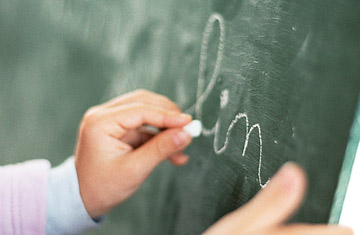
(2 of 2)
I entered third grade in 1990, the year of the great alphabet change. My teacher, Linda Garcia at Central Elementary in Wilmette, Ill., says my class was one of the last to learn the loops and squiggles. "For a while I'd show my kids both ways," she says. "But the new alphabet is easier for them, so now I just use that one."
Garcia, who has been teaching for 32 years, says her children consider cursive a "rite of passage" and are just as excited to learn it as ever. But once they leave her classroom, it's a different story. She doesn't know any teachers in the upper grades who address the issue of handwriting, and she frequently sees her former students reverting to old habits. "They go back to sloppy letters and squished words," she says. "Handwriting is becoming a lost art."
Why? Technology is only part of the reason. A study published in the February issue of the Journal of Educational Psychology found that just 9% of American high school students use an in-class computer more than once a week. The cause of the decline in handwriting may lie not so much in computers as in standardized testing. The Federal Government's landmark 1983 report A Nation at Risk, on the dismal state of public education, ushered in a new era of standardized assessment that has intensified since the passage in 2002 of the No Child Left Behind Act. "In schools today, they're teaching to the tests," says Tamara Thornton, a University of Buffalo professor and the author of a history of American handwriting. "If something isn't on a test, it's viewed as a luxury." Garcia agrees. "It's getting harder and harder to balance what's on the test with the rest of what children need to know," she says. "Reading is on there, but handwriting isn't, so it's not as important." In other words, schools don't care how a child holds her pencil as long as she can read.
Is that such a bad thing? Except for physicians — whose illegible handwriting on charts and prescription pads causes thousands of deaths a year — penmanship has almost no bearing on job performance. And aside from the occasional grocery list or Post-it note, most adults write very little by hand. The Emily Post Institute recommends sending a handwritten thank-you but says it doesn't matter whether the note is in cursive or print, as long as it looks tidy. But with the declining emphasis in schools, neatness is becoming a rarity.
"I worry that cursive will go the way of Latin and that eventually we won't be able to read it," says Garcia. "What if 50 years from now, kids can't read the Declaration of Independence?"
I am not bothered by the fact that I will never have beautiful handwriting. My printing will always be fat and round and look as if it came from a 12-year-old. And let's be honest: the Declaration of Independence is already hard to read. We are living in the age of social networks and frenzied conversation, composing more e-mails, texting more messages and keeping in touch with more people than ever before. Maybe this is the trade-off. We've given up beauty for speed, artistry for efficiency. And yes, maybe we are a little bit lazy.
Cursive's demise is due in part to the kind of circular logic espoused by Alex McCarter, a 15-year-old in New York City. He has such bad handwriting that he is allowed to use a computer on standardized tests. The U.S. Department of Education estimates that only 0.3% of high school students receive this particular accommodation. McCarter's mother tried everything to help him improve his penmanship, including therapy, but the teenager likes his special status. "I kind of want to stay bad at it," he says. These days, that shouldn't be a problem.
